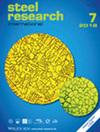SiO2 和 Al2O3 对建筑钢材生产过程中产生的电弧界面渣的热物理性质和发泡指数的影响
IF 1.9
3区 材料科学
Q2 METALLURGY & METALLURGICAL ENGINEERING
引用次数: 0
摘要
使用旋转粘度计和最大气泡压力法研究了不同二氧化硅和氧化铝含量的建筑钢材生产过程中产生的工业电弧炉(EAF)炉渣的粘度、密度和表面张力。此外,还讨论了热物理性质对发泡指数的影响。为了预测不同温度下熔渣中固相的行为,使用 FactSage 8.1 软件进行了热力学计算。实验证明,在所研究的熔渣体系中,SiO2 和 Al2O3 起着网络形成剂的作用,导致液态主导区域的粘度值增加,熔渣密度降低。氧化铝和二氧化硅的存在改变了熔渣在液态主导区的行为,使熔渣的断裂点发生变化。此外,二氧化硅的加入降低了炉渣的表面张力,证实了二氧化硅作为表面活性剂的作用。然而,由于纯氧化铝的表面张力较高,添加 Al2O3 会增加表面张力。因此,炉渣的发泡指数可增加 ≈40%,这主要是由于炉渣的聚合作用。本文章由计算机程序翻译,如有差异,请以英文原文为准。
Effect of SiO2 and Al2O3 on the Thermophysical Properties and the Foaming Index of Electric Arc Interface Slag from the Production of Construction Steel
Viscosity, density, and surface tension of an industrial electric arc furnace (EAF) slag from production of construction steel with varying SiO2 and Al2 O3 contents are investigated using a rotating viscometer and the maximum bubble pressure method. In addition, influence of thermophysical properties on foaming index is discussed. To predict the behavior of the solid phase in the slag at different temperatures, thermodynamic calculations are performed using FactSage 8.1 software. The experiments demonstratethat SiO2 and Al2 O3 act as network formers in the studied slag systems, resulting in increased viscosity values in the liquid‐dominant region and decreased density of the slag. The presence of alumina and silica altered the behavior of the slag in the liquid‐dominant region, shifting the breaking point of the slags. Furthermore, the addition of silica decreases the surface tension of the slag, confirming its role as a surfactant. However, the addition of Al2 O3 increases the surface tension due to the high surface tension of pure alumina. Consequently, the foaming index of the slag can increase by ≈40%, primarily due to the polymerization of the slag.
求助全文
通过发布文献求助,成功后即可免费获取论文全文。
去求助
来源期刊

steel research international
工程技术-冶金工程
CiteScore
3.30
自引率
18.20%
发文量
319
审稿时长
1.9 months
期刊介绍:
steel research international is a journal providing a forum for the publication of high-quality manuscripts in areas ranging from process metallurgy and metal forming to materials engineering as well as process control and testing. The emphasis is on steel and on materials involved in steelmaking and the processing of steel, such as refractories and slags.
steel research international welcomes manuscripts describing basic scientific research as well as industrial research. The journal received a further increased, record-high Impact Factor of 1.522 (2018 Journal Impact Factor, Journal Citation Reports (Clarivate Analytics, 2019)).
The journal was formerly well known as "Archiv für das Eisenhüttenwesen" and "steel research"; with effect from January 1, 2006, the former "Scandinavian Journal of Metallurgy" merged with Steel Research International.
Hot Topics:
-Steels for Automotive Applications
-High-strength Steels
-Sustainable steelmaking
-Interstitially Alloyed Steels
-Electromagnetic Processing of Metals
-High Speed Forming
 求助内容:
求助内容: 应助结果提醒方式:
应助结果提醒方式:


